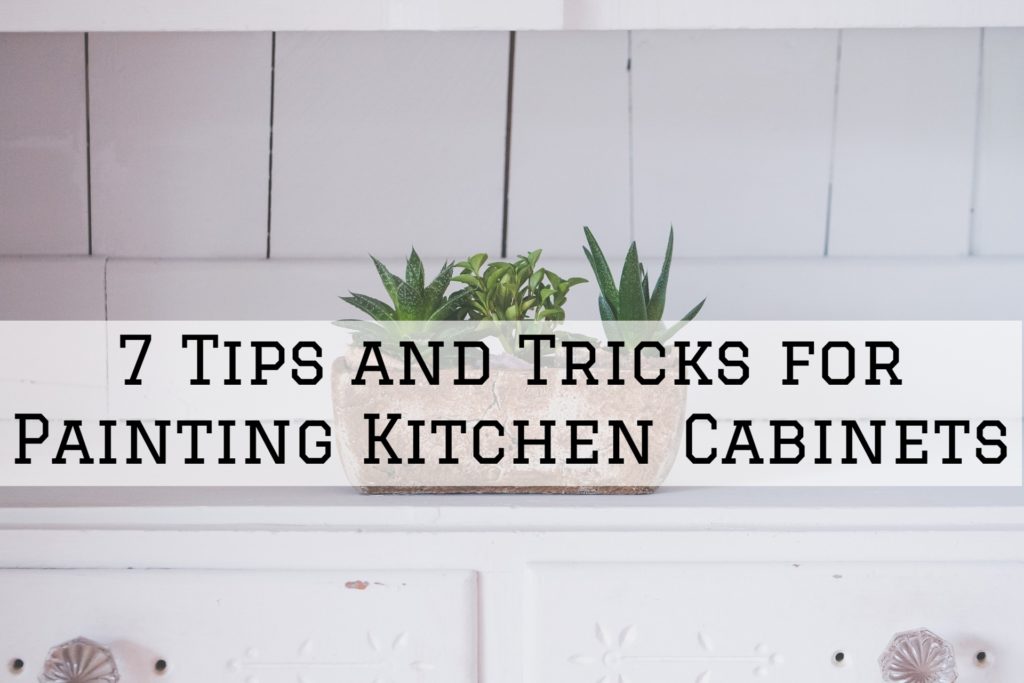7 Tips and Tricks for Painting Kitchen Cabinets in Omaha, NE
January 16th, 2020 | 3 min read
By Bill Carlson

7 Tips and Tricks for Painting Kitchen Cabinets in Omaha, NE
The kitchen is one of the most important rooms in any house or home, and within it one might say that the cabinets are fundamental for keeping everything together.
Though it is not necessary to have kitchen cabinets that are painted, from an aesthetic point of view it is nicer to have cabinets that are either painted or stained.
When you will come to paint your kitchen cabinets, or re-paint them as the case may occasionally be — as repainting kitchen cabinets is more cost effective than entirely replacing them — you want to make sure you do it right.
Bearing all of this in mind, here are seven tips and tricks for painting kitchen cabinets in Omaha, NE.
1. Remove Doors And Hardware Prior To Painting
It sounds counter-intuitive — pun not intended — that you would have to remove the kitchen cabinet doors prior to painting them — shouldn't you just be able to paint the doors while they are hanging on the cabinets?
The answer might surprise you and that is that you absolutely should not try to paint the cabinet doors while they are still attached to the cabinets.
The most efficient way to ensure that your kitchen cabinet doors are fully painted is to entirely remove them from the cabinets before you begin the painting process.
2. Make Sure Everything Is Properly Labeled
Now that you know that you are going to remove all the kitchen cabinet doors and the related hardware prior to beginning painting, how are you going to keep track of it all and make sure you put it all back exactly where you removed it?
You might think all the doors to the cabinets are more or less the same and you can just put them back wherever, but this is not the case at all.
The best way to make sure you put everything back exactly where you got it is to label everything in some meaningful manner and to put the smaller bits of hardware in some kind of storage containers so that nothing gets lost.
3. Paint Kitchen Cabinet Doors Flat, Not Upright
There is a huge difference when it comes to painting your kitchen cabinet doors in painting them flat versus painting them upright.
Painting kitchen cabinet doors while they are flat will always get you a better paint job and more even distribution of the paint than you will ever get if you try to paint them upright.
4. Sand Before Priming
Before you even start applying that first layer of primer paint, you will need to sand the surface of the kitchen cabinet doors and the kitchen cabinets themselves.
Though it is a step that many people skip while painting their kitchen cabinets, you cannot possibly compare the quality of a paint job that has been done after sanding versus one that has been done without sanding.
Do yourself a favor and make sure to sand the cabinets and doors prior to applying the primer.
5. Protect Everything Not Being Painted
It should probably go without saying that when you paint anything anywhere, there's going to be a mess that will be made in the form of paint that drips from the brushes as well as paint that drips when you are trying to get it out of the can.
The best thing you can do for yourself to make sure that paint only goes exactly where you want it is to cover absolutely everything that is not going to get painted with some kind of protecting shield, be it a drop cloth or special paper that rolls out and covers your kitchen counters.
6. Sometimes Spray Application Is Better
There are plenty of cases where you will have a perfectly good time painting your kitchen cabinets with brushes and brush rollers.
However, this being the case, you can sometimes have an easier time using a paint sprayer to paint your kitchen cabinets.
If your kitchen cabinet doors have any recesses, however, then the spray application absolutely will not be your friend and you are better off with a combination of brushes and brush rollers.
7. Don't Forget To Remove All The Grease!
When you go to get your cabinets ready for painting, the first thing you should know to do is to clean them.
What a lot of people don't realize is that part of the cleaning process includes removing the grease — and people don't even realize that there's grease on their cabinets.
Think about it -- when you're cooking, grease will inevitably get in your kitchen and this includes your kitchen cabinets.
There are special cleaners that properly remove grease from surfaces -- use one of these to remove the grease from your kitchen cabinets and then wash off with water, letting everything dry prior to beginning the painting process.
If you would rather hire a professional to help you with molding and trim in Omaha, NE, our team at Brush & Roll Painting can help.
To get started with us, book a FREE estimate below or call us on 402-932-9764 for more details.
Related: Kitchen Cabinet Painting, Omaha, NE : Critical Steps To Consider
8 Tips For Choosing A Color For Your Interior Painting Project In Omaha, NE
Should You Ask Painters In Omaha, NE To Use Non-VOC Paints?
Bill is the owner and operator of Brush & Roll Painting.
Topics:
